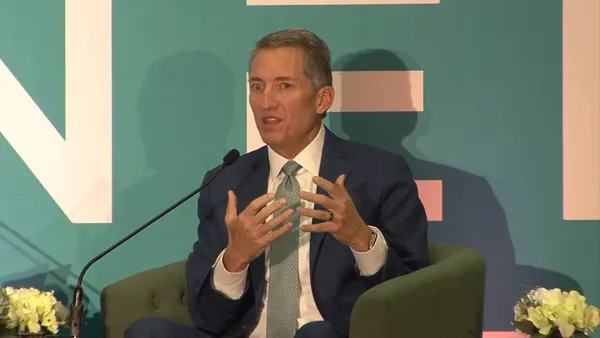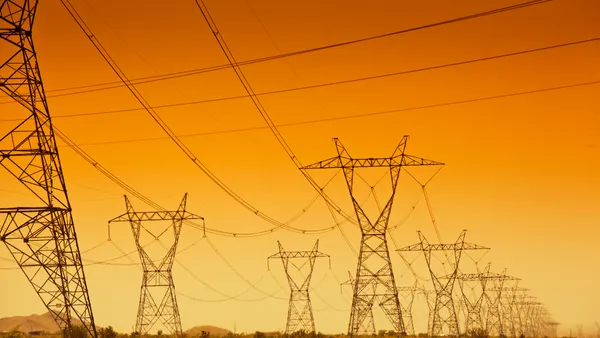Dive Brief:
- Pacific Gas & Electric (PG&E) received court approval Tuesday for a contingency plan that is part of a series of commitments it made to win the support of California Gov. Gavin Newsom, D, — but a committee representing victims of the Northern California wildfires has raised fresh concerns about the utility's plan to exit bankruptcy.
- The committee is concerned that the payouts promised to victims by PG&E — half of which are based on company stock — could be reduced by recent changes to its bankruptcy plan and the economic consequences of the COVID-19 pandemic.
- PG&E is still on track to exit Chapter 11 bankruptcy by June 30 — a requirement to participate in California's wildfire insurance fund — despite the concerns raised by the committee, utility lawyer Stephen Karotkin told U.S. Bankruptcy Judge Dennis Montali during a hearing.
Dive Insight:
The contingency plan marks "the final piece of the puzzle," Karotkin said during the telephonic hearing. Newsom had previously raised concerns that aspects of PG&E's plan did not align with Assembly Bill 1054, a state bill passed in 2018 that created a framework for its eventual emergence from Chapter 11 bankruptcy.
In response, PG&E made a series of commitments to the governor, including barring dividends for three years, supporting regulators' efforts to reform its internal governance, and promising not to recover from ratepayers the $25.5 billion it has allocated to resolving the wildfire-related liabilities that pushed it into Chapter 11 bankruptcy in early 2019.
In addition, the utility agreed to a contingency plan in case it did not have a confirmed bankruptcy exit plan by June 30, which could include launching a formal process to sell the company to either the state of California or another bidder.
That process is "purely contingency planning," Karotkin told U.S. Judge Dennis Montali at the hearing, since the utility believes it will meet the deadline. In fact, failing to approve those conditions — and thereby, the support of Newsom — would be "a substantial setback" with "very serious consequences to all parties and interests, and in particular fire claimants," he added.
Montali approved the motion during the hearing, acknowledging that it is simply a contingency plan and would hopefully "never see the light of day."
The judge also heard arguments on additional concerns from the tort claimants committee, which represents victims of the wildfires caused by PG&E's power lines in Northern California. The committee reached a deal with PG&E in December, based on a $13.5 billion trust, composed of half cash and half company stock, to resolve the victims' claims.
The victims of the fires, as well as PG&E's other creditors, have to vote on PG&E's plan anytime before May 15. But on Monday, the tort claimants committee asked for the court's approval to send out a letter asking victims not to vote until May 1, to provide for additional time to resolve their issues.
The committee fears that multiple events could reduce the value of the victims' $6.75 billion stock-based payments, including the COVID-19 pandemic and the fact that PG&E has increased its total debt by $3.7 billion since their initial agreement. These events "present an unforeseeable and significant risk that the shares of stock will not have the value necessary to match the $13.5 billion that PG&E has stated would be available to pay [victims]," it said in its motion.
Robert Julian, an attorney representing the tort claimants committee, pointed to a filing made in a parallel legal proceeding involving PG&E, in which a restructuring expert said that current market conditions have reduced the $6.75 billion in stock promised to wildfire victims to $4.85 billion.
"The coronavirus impact, when you combine it with the fact that they are no longer having a plan that has $12 billion of equity, creates a problem for us," Julian said, adding that he reached out to PG&E and other proponents of its plan about these issues on March 8 but was told they would "gum up the works" in getting the utility's plan confirmed.
But PG&E's Karotkin said that the issues raised by the committee are not new ones.
"This is a blatant attempt to renegotiate the deal that they signed," he said, adding that their initial agreement did not provide any guarantees as to the value of the stock. He also said that notwithstanding disruptions associated with COVID-19, PG&E Corp's stock price is nearly $9 a share, which is 12% higher than the average trading price during the two months preceding their deal with the tort committee.
The company's share price was at $8.57 as of close of market Tuesday.
Montali rejected the tort committee's ask in an order filed hours after the hearing, noting that hundreds, if not thousands, of fire victims have already cast votes on PG&E's plan. Sending out a court-approved letter asking victims to hold out on voting would raise questions about whether previously cast votes are valid and could potentially lead to some voters missing the deadline, he said.
However, the committee is still free to voice any concerns about PG&E's plan to the victims — but if it does so, that is "without this court's approval or disapproval," Montali wrote.
PG&E's plan is "the best method for victims to receive compensation," utility spokesperson Ari Vanrenen said in an emailed statement.
"Since PG&E entered Chapter 11, the company's primary goal has been to get victims paid fairly and timely. PG&E is on path to get its [plan] approved by the Bankruptcy Court by the June 30, 2020 deadline to participate in the state's new go-forward wildfire fund, and to fund the Fire Victim Trust as soon as possible thereafter."













